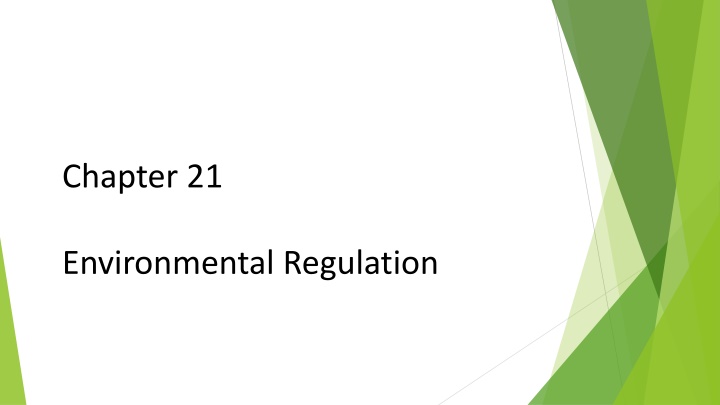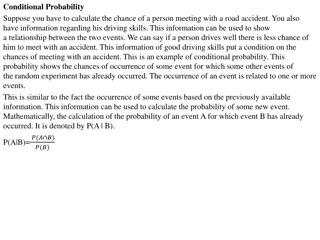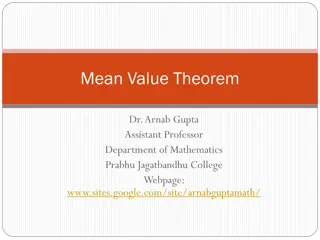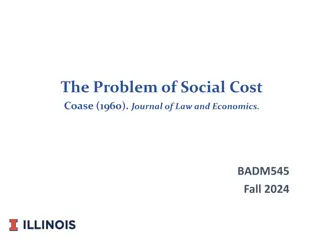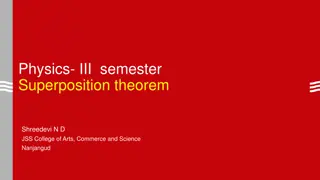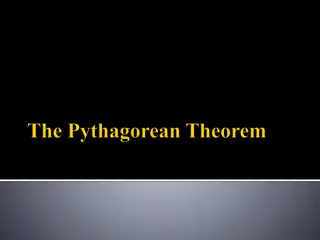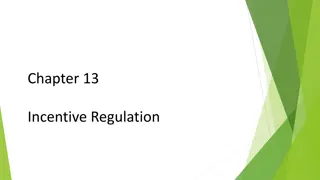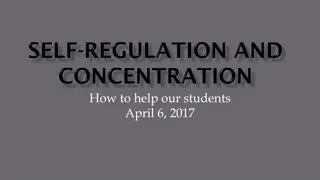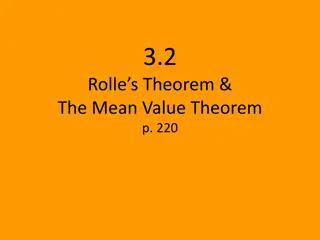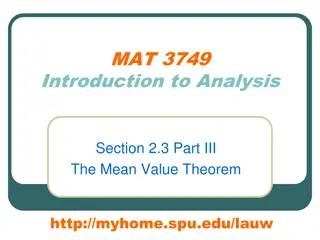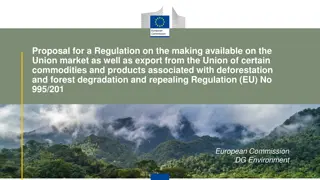Environmental Regulation and Coase Theorem Exploration
This content delves into environmental regulation with a focus on the Coase Theorem, analyzing externalities and pollution problems. It explores scenarios involving property rights allocation, long-run efficiency concerns, transaction costs, smoking externalities, and special features of environmental contexts like hazardous waste disposal and nuclear waste siting. Through examples and discussions, it highlights the complexities and considerations in addressing environmental issues from an economic standpoint.
Download Presentation

Please find below an Image/Link to download the presentation.
The content on the website is provided AS IS for your information and personal use only. It may not be sold, licensed, or shared on other websites without obtaining consent from the author.If you encounter any issues during the download, it is possible that the publisher has removed the file from their server.
You are allowed to download the files provided on this website for personal or commercial use, subject to the condition that they are used lawfully. All files are the property of their respective owners.
The content on the website is provided AS IS for your information and personal use only. It may not be sold, licensed, or shared on other websites without obtaining consent from the author.
E N D
Presentation Transcript
Chapter 21 Environmental Regulation
The Coase Theorem for Externalities Ronald Coase: developed the fundamental theorem in the area of externalities Review Coase s consideration of the generic problem of a cattle rancher The Coase Theorem as a Bargaining Game Explore in detail what Coase did not, i.e., the nature of the bargaining process that would lead to the efficient outcome that he discussed Bargaining range and bargaining rent
Pollution Example Utilize the bargaining game framework to analyze the Coasean pollution problems: first, consider the situation in which the citizen victims of pollution are assigned the property rights, and then consider a situation in which the polluter has been assigned the property rights Long-Run Efficiency Concerns The difference in the equity of the two pollution situations is substantial; this short-run equity issue is also a long-run efficiency issue If firms are in effect being subsidized for their pollution by citizens paying for their pollution control equipment, then there will be too much entry and too much economic activity in the polluting industries of the economy
Transaction Costs and Other Problems One factor pertaining to the bargaining process that Coase emphasized is that substantial transaction costs may be involved in carrying out these bargains There is also a potential for strategic behavior, but perhaps the greatest caveat pertains to the degree to which one can distinguish discrete and well-defined assignments of the property rights; ultimately, Coase theorem does serve an important purpose from the standpoint of regulatory economics Smoking Externalities Consider the application of the Coase theorem and Coasean logic to cigarette smoking Then consider the involvement of factors such as the government, the market, and insurance (the medical cost)
Special Features of Environmental Contexts Define nonconvexities Consider the example of how to disperse hazardous wastes (NIMBY: not in my backyard) Siting Nuclear Wastes The Yucca Mountain site in Nevada was developed as the central repository for unspent nuclear fuel; consider the scenarios of how this site may become risky How might economists have approached nuclear waste siting issues differently?
Selecting the Optimal Policy: Standards versus Fines Setting the Pollution Tax How would a lawyer and economist approach the question of how one should structure regulatory policy differently? The market shortcomings that give rise to the rationale for government regulation stem not only from the character of the cost function but from the relationship of these costs to the benefits of controlling environmental externalities that would not otherwise be handled in an unregulated market context The choice between taxes and quantity constraints is not simply a question of administrative feasibility; there are also important dollar stakes involved
Role of Heterogeneity It may be easier for some industries to comply with pollution requirements given the character of their technologies; if so, the standard should be set more stringently in these cases to recognize the difference in the marginal costs of compliance Consider new source bias Standard Setting under Uncertainty Setting the optimal standard is most straightforward when compliance costs and benefits arising from policies are known; in the usual policy context, there is substantial uncertainty regarding these magnitudes Consider a case in which the cost uncertainty is likely to be greater than the benefits uncertainty
Pollution Taxes Consider a figure illustration of a pollution tax approach to promoting optimal pollution control, then consider whether the pollution control level should be achieved through a standard or the fine system and the two classes of issues raised by the difference in outcomes Prices versus Quantities Martin Weitzman Examine the situation in which the absolute value of the slope of the marginal cost curve exceeds that of the marginal benefit curve and the situation in which the absolute value of the slope of the marginal benefit curve exceeds that of the marginal cost curve
Market Trading Policies Netting Four types of emissions trading options that have been employed for decades are netting, offsets, bubbles, and banking Under the netting system, a firm can alter its current plant and equipment in a manner that increases the pollution emissions from one source at the plant, provided that it also decreases the emissions from other sources, so that the net increase does not equal that of a major source Offsets The second most frequent market trading activity is offsets; under an offset option, firms will be permitted to construct new facilities in a part of the country that exceeds the EPA s maximum permissible level of pollutants
Bubbles The bubble concept was introduced in December 1979 by the Carter administration Under this concept, a firm does not have to meet compliance requirements for every particular emissions source at a firm Banking Under the banking policy, firms in compliance with their standards can store pollution rights over time and then use these rights in the future as an offset against future pollution; this policy has been used infrequently
The Expanding Role of Market Approaches A major policy shift occurred in the 1990s Advantages of tradable pollution rights: (1) they enable the EPA to equalize the opportunity costs of pollution control; and (2) they encourage innovations to decrease pollution The disadvantage of pollution rights is that we must set the number of such rights Critics of pollution rights systems ask whether the market participants are really trading a uniform good, and another concern relates to market power The greatest resistance to the marketable permit scheme is the general suspicion of markets among noneconomists
Cap and Trade in Action: The SO2 Allowance Trading System Market-based approaches to environmental problems are not hypothetical constructs; they have been employed in a variety of air pollution contexts in the United States as well as for CO2 emissions in the European Union Title IV of the Clean Air Act Amendments of 1990 introduced the SO2 allowance trading program Consider the temporal pattern of sulfur dioxide allowance prices to understand the substantial fluctuation over time in SO2 prices The total estimated benefits of the SO2 allowance trading program are $59 billion to $116 billion; these amounts dwarf the cost estimates because of the health benefits associated with the mandated 50 percent reduction in SO2 emissions
Global Warming and Irreversible Environmental Effects The environmental policies of the 1970s focused primarily on conventional air and water pollutants, efforts of the 1980s turned to toxic chemicals and hazardous waste, and attention in the 1990s shifted to the long-term character of Earth s climate The accumulation of carbon dioxide and other trace gases in Earth s atmosphere in effect has created a greenhouse around Earth, and scientists have estimated that this change in Earth s atmosphere is expected to increase global warming Consider the effect that global warming will have on society Review the Stern Review, The Economics of Climate Change, and William Nordhaus s critique of the Stern analysis
Policy Options for Addressing Global Warming Social Cost of Carbon Approaches that could be used to address global warming include policy options, the policy mix that the Stern Review suggested, and carbon taxes Instead of setting a price on carbon, policymakers could focus on quantity through a cap and trade system that provides a fixed number of tradable permits that firms are permitted to buy and sell to address their carbon emissions; an alternative to these market-based systems is the use of clean energy standards to serve as technology standards for generating lower emissions The social cost of carbon (SCC): the present value of the costs imposed by the emission of another ton of carbon The Interagency Working Group on the Social Cost of Carbon established a consensus SCC figure to be used for agency policy analyses and the study drew on three different integrated assessment models that they used to draw from three different sources
Assessing the Merits of Global Warming Policies Consider the approach taken by economists such as William D. Nordhaus, and the three policy options shown Whereas in most environmental contexts, it is the marginal costs that are more uncertain than the marginal benefits, in this long-run environmental context, benefits also pose substantial uncertainty How Should We React to Uncertainty? The no regrets policy: a supported option that states we should clearly adopt policies, such as energy conservation, that would be desirable irrespective of what we ultimately learn about the implications of climate change Examine the classic irreversible development decision situation, e.g., whether one should err on the side of underdevelopment or not
Multiperson Decisions and Group Externalities Externality problems become particularly complex in the context of group decisions For example, environmental problems are becoming increasingly global in scope and require international cooperation In 1987, more than 190 countries signed the Montreal Protocol on Substances that Deplete the Ozone Layer to phase out chemical products that were depleting the ozone layer The December 2015 Paris Agreement likewise was an international agreement in which 195 countries committed to keeping the global temperature increase below a 2 degrees Celsius increase from the preindustrial levels
The Prisoners Dilemma The standard situation in bargaining theory where uncoordinated action gives rise to an inferior outcome is that of the Prisoner s Dilemma, where the outcome is best for both prisoners if neither talks The N-Person Prisoner s Dilemma Consider a multiperson Prisoner s Dilemma, using a methodology developed by Nobel laureate Thomas C. Schelling, where the particular context being considered is the purchase of a large or small car Applications of the Prisoner s Dilemma Consider cases where group externalities arise, such as international whaling and vaccination in society; the general result is that explicit regulations are often worthwhile
Enforcement and Performance of Environmental Regulation Enforcement Options and Consequences To ensure firms comply with regulations, the EPA and other regulatory agencies couple the issuance of regulations with vigorous enforcement efforts The enforcement task with respect to conventional pollutants is generally viewed as being the simplest. Next in terms of the degree of difficulty is enforcement with respect to toxic chemicals, e.g., the EPA Toxics Release Inventory (TRI) The enforcement tools that the EPA can use include inspecting a firm, requesting the firm provide data to the EPA, sending the firm letters, or meeting with the firm s managers to discuss pollution control problems
Hazardous Wastes Public opinion polls typically rank the cleanup of hazardous wastes as one of the most important environmental problems; beginning in the 1980s, the EPA started the Superfund Program to help eliminate the risks posed by these chemical waste sites Since the cleanup costs will be borne largely by the potentially responsible parties, which are private firms rather than the citizens affected by the hazard, there will be considerable political pressure for uncompromising cleanup remedies, such as removing the contaminated waste from the site and incinerating it Before deciding on the level of the hazard, the EPA must first ascertain who lives near the site and will be exposed to the risk; however, for the EPA to find a risk, there need not be a population actually exposed to the hazardous waste site When calculating the individual cancer risk at a site, the EPA uses conservative risk estimates (the 90 10 principle)
Contingent Valuation for the Exxon Valdez Oil Spill Using contingent valuation techniques, researchers design survey questions to elicit the values that people attach to scarce environmental resources for which no good market values exist The Exxon Valdez oil spill, for which damage levels were in the billions of dollars, considerably raised the stakes of the economic debate over the soundness of contingent valuation techniques Consider the contingent valuation study undertaken by the state of Alaska as part of the litigation over the environmental damage Define criterion validity, convergent validity, construct validity, and content validity
Senior Discount for the Value of a Statistical Life The 2003 EPA generated Clear Skies Initiative Theoretically, the value of a statistical life should rise and then eventually fall over the life cycle, but the main open question asks how much this value declines for those with short life expectancies Evaluating Performance The objective of regulatory policy is not simply to promulgate and enforce regulations but also to improve environmental outcomes Consider a summary of the pollution trends from 1970 to 2014 for seven principal categories of air pollution emissions
Summary Environmental problems represent a classic situation in which an externality is being imposed involuntarily; what is most noteworthy about this situation is that the optimal level of pollution is not zero Our review of the Coase theorem indicates that the main focal point should be the efficient pollution level Concerns arose with respect to the choice of standards versus fines Considerable insight can be obtained by assessing how efficient markets would deal with externalities, if such markets existed
